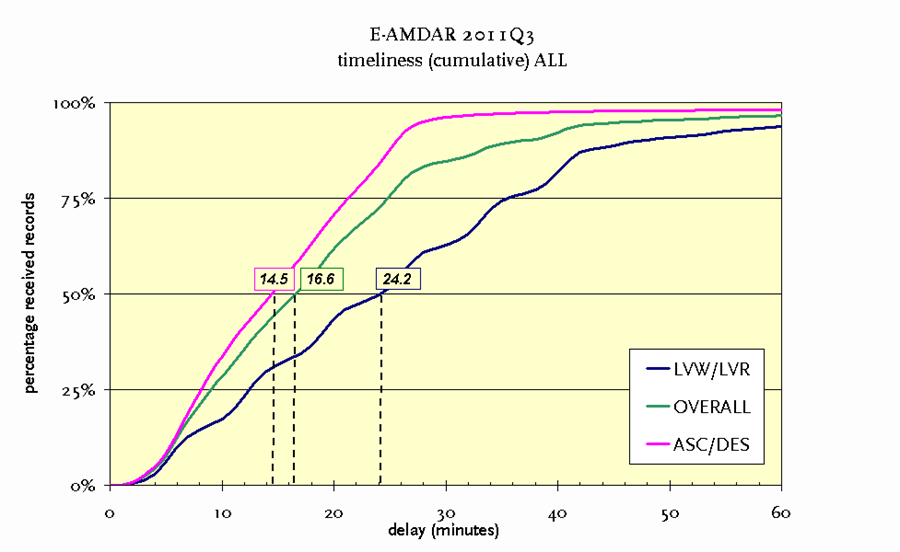The AMDAR Observing System Description
Contents |
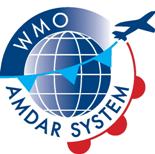 |
Links |
|
|
Introduction
The definitive source for information on the AMDAR system and related programmatic procedures and processes is contained within the references, manuals and guides that are referenced from the AMDAR/Resources site.
1. AMDAR System Components
The AMDAR system predominantly utilises existing aircraft onboard sensors, computers and communications systems to collect, process, format and transmit meteorological data to ground stations via satellite or radio links. Once on the ground, the data is relayed to National Meteorological and Hydrological Services (NMHS), where it is processed, quality controlled and transmitted on the WMO Global Telecommunications System (GTS).
The full AMDAR system, as depicted in the figure below, comprises the end-to-end system of processes and practices, starting from measurement by aircraft sensors right through to the delivery of the data to Data Users.
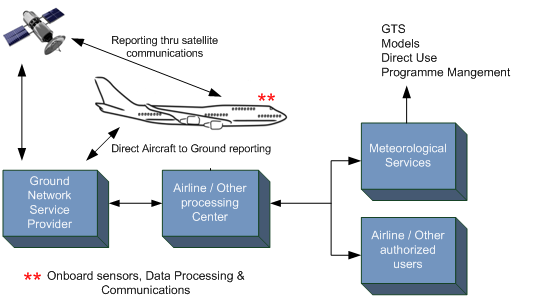
The essential components and basic building blocks of the AMDAR system are:
- The onboard AMDAR system;
- The air-to-ground communications system;
- The ground-to-ground communications system;
- The ground-based data processing system; and,
- The ground-based data optimisation system.
On the aircraft, Aircraft Data Computers obtain process and format data from onboard sensors, and transmit data to ground via standard aircraft communication systems. Once on the ground, the data are relayed to the NMHS and other authorized users Data are received at the data processing centers of the NMS where they are decoded and undergo basic quality control checks before being reformatted for distribution to Data Users both internal to the NMHS and externally to other NMHSs via the WMO Global Telecommunication System (GTS).
More information:
2. AMDAR Data Derivatives
AMDAR data is processed, compiled and transmitted by the Onboard AMDAR System according to the sampling algorithms and frequencies defined in the AMDAR Onboard Software standards.
Vertical profiles of AMDAR data are derived as the aircraft is on ascent or descent and en-routed data is derived as the aircraft flies at cruise altitudes of around 35,000 feet (10,500 metres).
From the innate Onboard AMDAR System, the following meteorological parameters can be measured or derived:
- Air temperature (static air temperature)
- Wind speed and direction
- Pressure altitude (barometric pressure)
- Turbulence (Eddy Dissipation Rate or Derived Equivalent Vertical Gust)
Additional non-meteorological parameters that can be reported, measured or derived include:
- Latitude position
- Longitude
- Time
- Icing indication (accreting or not accreting)
- Departure and destination airport
- Aircraft roll angle
- Flight number
Water Vapour Measurement
A water vapour (humidity) measurement from the aircraft platform can also be derived through the deployment and avionics integration of a water vapour sensor. Currently there is a single laser-diode sensor that delivers the required data quality and performance for operational deployment, namely the Water Vapour Sensing System 2nd Generation, WVSS-II, which has been deployed operationally in the USA (around 100 aircraft by mid-2013 on UPS and Southwest Airlines). Plans are also in place to commence deployment of the sensor in Europe and Australia.
More detailed information is available from:
- WMO-No.1200, Guide to Aircraft-Based Observations
- WMO Guide to Meteorological Instruments and Methods of Observations, WMO-No. 8, Part II Chapter 3
3. Onboard AMDAR System
The AMDAR system is defined by the characteristic that it is a meteorological observing system that utilizes aircraft innate sensors and onboard avionics and communications systems in order to collect process and transmit meteorological data that has been defined, sampled and processed according to WMO meteorological specifications. This latter and very important aspect means that features and functions such as data acquisition, data quality control and processing, reporting frequency and data latency are handled so as to meet meteorological requirements.
The purpose of the airborne part of the AMDAR system (Onboard AMDAR System) is to collect, process and transmit meteorological data from sensors onboard the aircraft.
An example of a typical Onboard AMDAR System is depicted in the figure below.
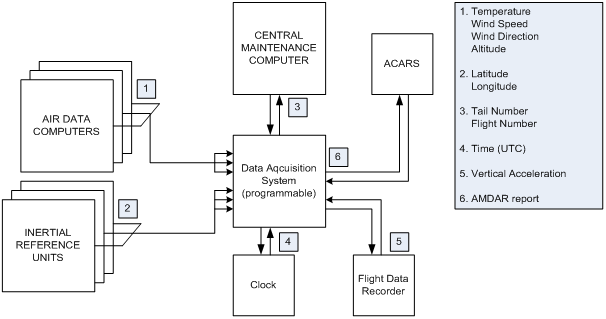
In reality, the Onboard AMDAR System is a combination of existing sensors and systems on the aircraft, combined with the AMDAR Onboard Software or AMDAR software application.
More Information:
- WMO-No.1200, Guide to Aircraft-Based Observations
- WMO Guide to Meteorological Instruments and Methods of Observations, WMO-No. 8, Part II Chapter 3
4. AMDAR Onboard Software
The role of the AMDAR Onboard Software is to facilitate the functions and the required system interfaces of the Onboard AMDAR System.
The primary functions of the AMDAR Onboard Software are:
- Interface to and accept input data from a variety of aircraft innate avionics equipment;
- Perform high level quality checks on the input data;
- Perform calculations upon the input data to derive required meteorological variables;
- At set intervals, process collected data into standard output messages for transmission to ground stations; and,
- Accept and process inputs, allowing users to alter the AOS behavior.
Given that the full functionality of AMDAR Onboard Software is quite processing and computationally complex and demanding, the AMDAR system relies on and is usually best employed in modern, larger commercial aircraft, which will tend to have the necessary avionics, data computers and communications systems.
The current AMDAR Observing System relies on the communications protocols defined for the Aircraft Communications and Reporting System (ACARS), which are specified within the standards of the Aeronautical Airlines Electronic Engineering Committee (AEEC).
WMO currently specifies and maintains two meteorological standards for AMDAR Onboard Software:
- The AMDAR Onboard Software Functional Requirements Specification (ASOFRS), which supersedes the ACARS Aircraft AMDAR (AAA) specification series (versions 1 to 3).
- The "ARINC 620" AMDAR Onboard Software versions 1 through 5, are defined within the AEEC 620-7 Data Link Ground System Standard and Interface Specification (DGSS/IS), which is maintained by the AEEC Data Link Systems Sub-committee. Within the specification, AMDAR reporting formats and functionality are defined through the definition of the Meteorological Report,versions 1 to 5.
The AOSFRS and the ARINC 620 specifications both rely on the basic DGSS/IS ACARS protocols but have different uplink and downlink formats. The specifications are provided from this site within the AMDAR/Resources area.
More Information:
5. Communications
Setting aside the GTS communications component for the final delivery of data to data users, there are two components of communications relevant to the AMDAR Observing System: the aircraft-to-ground, and the ground-ground communications.
The current AMDAR Observing System relies on the communications protocols defined for the Aircraft Communications and Reporting System (ACARS), which are specified within the standards of the Aeronautical Airlines Electronic Engineering Committee (AEEC).
More detailed information on ACARS is available from the Section 1.4 of the ARINC 620 specification.
Air-to-ground Communications
Modern aircraft will generally have two possible solutions for communications with the ground: VHF radio communications allow both voice and data transmission from the aircraft, whilst satellite communications provide the same functionality but at much greater expense.
Standardised data services for aviation are provided by two major Data Service Providers, namely: ARINC and SITA. These two international corporations have established both VHF and satellite communications networks in support of ACARS communications.
ARINC Communications
- The ARINC VHF coverage maps are available from ARINC's website here.
- Information on ARINC satellite coverage through Iridium is available here.
SITA Communications
- Information on SITA Type B messaging services is available here.
- Information on SITA communications coverage is available here.
While onboard avionics applications requiring ground communications via ACARS can utilise both VHF and satellite communications systems, AMDAR software applications are generally configured to use only the VHF communications channel for data delivery. This can mean that en-route reports, compiled over locations where VHF coverage is not available, can be delayed by up to several hours and longer on long-haul international flights.
However, as the graphic at right demonstrates (click to enlarge), the majority of AMDAR reports are delivered within minutes and, for the E-AMDAR programme, 50% of vertical profile data is delivered in under 15 minutes, while over 90% is available within 30 minutes.
[Graphic courtesy of the E-AMDAR Programme.]
Ground-to-Ground Communications
Given that ACARS air-to-ground data delivery relies on the satellite and VHF communications networks of the two major corporate, aviation Data Service Providers (DSP), it usually makes sense to employ these same DSPs to provide a solution for ground-to-ground communications, and the solution will usually be heavily dependent on the communications solution employed by the partner airline.
Generally, there will be two options for AMDAR ground-to-ground communications configuration and delivery to the NMHS:
- AMDAR reports are delivered directly from the aircraft to the NMHS; or,
- AMDAR reports are delivered via the partner airline.
In the first case, where AMDAR data is delivered directly to the NMHS from the DSP, it will be necessary for the NMHS to establish a communications link with the DSP, which would usually involve both a hardware and software installation and possibly a dedicated communications link to the DSP communications hub, although, more frequently, the latter can be established through the use of the Internet and Internet data transfer protocols (e.g. TCP/IP or FTP). If this solution is adopted, it will also be necessary to consider what computing or terminal "back-up" arrangements are necessary to ensure the required level of data reception reliability.
In the second case, where data is delivered to the airline and subsequently relayed to the NMHS, there are many possible solutions, which may or may not require the involvement of the DSP that is utilised by the airline for data delivery. In some cases, it may be convenient, more cost-effective and sufficient to establish an Internet-based data transfer solution (e.g. FTP or Email) directly with the partner airline, however considerations such as data delivery reliability and timeliness need to be assessed.
Communications Costs
By far the biggest contributor to ongoing costs for the operation of an AMDAR system are the communications costs, of which the air-to-ground component will always be the most expensive. These costs are variable and will depend heavily on many factors associated with the communications solution employed and the arrangements and agreements put in place with the partner airline and the DSP.
Generally, operators of AMDAR Programmes have been able to establish communications solutions that deliver AMDAR data to the NMHS for considerably less that US$0.10 per observation.
While a DSP will usually employ their standard charges for data service provision, NMHSs can make a strong case with partner airlines, given the mutual benefit of the programme, that data communications costs associated with the AMDAR Programme should be shared or, at most, delivered to the NMHS at the additional incremental cost to the airline only.
Communications costs can be considerably reduced through use of the configuration parameters within the AMDAR Onboard Software that control data output and also through the development and implementation of an AMDAR Data Optimisation System.
6. Ground-based Data Management & Processing
The requirements and procedures for ground-based processing and management of AMDAR data as first received in report form from the Onboard AMDAR System are outlined in Appendices A to C of the WMO Guide to Aircraft-Based Observations, WMO-No. 1200.
Generally the requirements for ground-based AMDAR data management and processing are:
- Receive and decode the downlinked data reports as transmitted from the aircraft using ACARS protocols and standard data formats;
- Undertake standard data quality assessment and control procedures;
- Reprocess good quality data into standard data formats for transmission on the WMO GTS;
- Archive data; and,
- Undertake standard data quality monitoring procedures.
1.1 AMDAR Data Management (AMDARDM) can be viewed within the context of the WMO WIGOS Data Quality Monitoring System (WDQMS). The concept of WDQMS is carrying out those activities required to optimize the integration of the Global Observing System (GOS), Global Telecommunications System (GTS) and Global Data Processing System (GDPS).
WWWDM functions include:
(a) Providing specifications for data representation, including codes and exchange formats, guidelines for the design of databases and storage of observational data and processed information;
(b) Defining and designing proper procedures and interfaces, particularly in the area of data processing and telecommunications, to allow Members to obtain the coherent and appropriate sets of data and products required, despite the disparity in the levels of sophistication of technology and techniques of various WWW centres; and
(c) Monitoring AMDAR operations and the quality of basic data and output products.
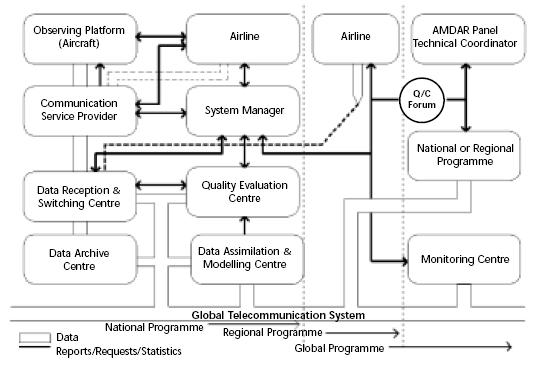 1.2 AMDARDM applies to all the processes in the AMDAR operational system. This is shown schematically in Figure 1 below [At right - click to enlarge]. It will be noted that the global system consists of several national or regional programmes with overall coordination facilitated by the WMO AMDAR Panel through its Technical Coordinator. In this appendix, each function is described with special attention given to quality management. In addition, detailed information is provided on recommended GTS codes that are subject to WMO Technical Regulations.
1.2 AMDARDM applies to all the processes in the AMDAR operational system. This is shown schematically in Figure 1 below [At right - click to enlarge]. It will be noted that the global system consists of several national or regional programmes with overall coordination facilitated by the WMO AMDAR Panel through its Technical Coordinator. In this appendix, each function is described with special attention given to quality management. In addition, detailed information is provided on recommended GTS codes that are subject to WMO Technical Regulations.
Pre-processing of AMDAR Downlink Data
Specific information relating to AMDAR downlink formats and procedures for pre-processing of AMDAR reports is available in Appendices A and C of the WMO Guide to Aircraft-Based Observations, WMO-No. 1200.
AMDAR downlink formats are described in the AMDAR Onboard Software standards.
Processing of Data for Transmission on the GTS
The general requirements for transmission of data on the GTS are described in the WMO Manual on Codes, WMO-No. 306.
AMDAR data is currently transmitted in both text (FM42, see Manual on Codes, Volume I.1 Alphanumeric Codes) and binary (FM94, see Manual on Codes, Volume I.2 Binary Codes) formats.
Specific information and procedures for pre-processing of AMDAR data for transmission of on the GTS is available in Appendix C of the WMO Guide to Aircraft-Based Observations, WMO-No. 1200.
Archival of AMDAR Data
At the current time, the long-term archival of AMDAR data is the responsibility of the NMHS.
7. Quality Management System
At the most general level, the AMDAR Quality Management System should be developed in line with the WIGOS quality management framework and Data Quality Monitoring System.
The full data quality management system is comprised of many components, including:
- Aircraft systems and sensor quality management;
- Onboard AMDAR System quality management;
- AMDAR Onboard Software quality management; and
- Data quality management (onboard & ground-based).
The first two elements lie chiefly in the domain of the participating airline and the second two are well-covered in Appendices A and B of the WMO Guide to Aircraft-Based Observations, WMO-No. 1200.
It should be noted that WIGOS regulatory material also provide a general framework for quality management of observing systems, including the AMDAR Observing System - the ABO/Resources site for more information.
8. Data Quality
If standards for the AMDAR Observing System are implemented and maintained through the employment of a Quality Management System, then the system delivers meteorological data that is considered and demonstrated to be the equivalent in quality to air temperature and wind data derived from the radiosonde system and meet the majority of Requirements of the Observing System Capabilities and Review Tool and the Accuracy Requirements for Upper-Air Measurements for Synoptic Meteorology as specified in the WMO Guide to Meteorological Instruments and Methods of Observations, WMO-No. 8 , Chapters 12 and 13.
Under such a QMS, the expected uncertainties for basic AMDAR data parameters are given in the AMDAR Reference Manual Section 2.5:
- Air Temperature: around 0.5C
- Wind vector: around 2 to 3 m/s
- Pressure altitude (barometric pressure): around 3.5 to 4.0 hPa
As outlined in the section above on the AMDAR Quality Management System, data management and in particular, data quality management, data quality control and data quality evaluation (monitoring) are key aspects of the AMDAR QMS.
AMDAR Data Quality Monitoring
While there are important but a limited number of quality control checks that can be applied to AMDAR data in its pre-processing prior to GTS transmission, another critical aspect of the AMDAR Quality Management System is the routine monitoring of data both at the national level by AMDAR data managers and also by international data monitoring centres, through the procedures of the World Weather Watch, Data Processing and Forecasting System, Observational Data Quality Monitoring procedures.
The Lead Centre for aircraft-based data monitoring is the World Meteorological Centre, Washington, with the data monitoring processes carried out by the USA National Weather Service, National Centers for Environmental Prediction, Central Operations.
At the current time, aircraft and AMDAR data monitoring is limited to the compilation and notification of monthly Numerical Weather Prediction (NWP) comparison reports that are available online from:
Other international NWP centers also provide aircraft-based observations data monitoring services and information to the international AMDAR community. More information and data monitoring results and statistics are available from this site under Aircraft-based Observations/Data.
Under the WMO Aircraft-Based Observations programme and WIGOS, WMO is developing the WIGOS Data Quality Monitoring System, for which the expected functionality and procedures are described in Appendix B of the WMO Guide to Aircraft-Based Observations, WMO-No. 1200.
9. Data Optimisation
AMDAR data optimisation is the process of ensuring that:
- National regional and global requirements for AMDAR upper-air data coverage are met; and,
- Redundant data and cost levels are minimised.
While AMDAR Onboard Software contains software configuration parameters and functions for optimising reporting, such as geographical area and time limiting and vertical profile targeting by airport, when limited to this onboard functionality, AMDAR systems and programmes can still produce redundant data levels of up to 50% to 70%, depending on the meteorological requirements for vertical profile data, the size of the AMDAR fleet and the density of AMDAR aircraft at particular airport locations and the time of day.
Given the significant communications costs associated with the AMDAR system, AMDAR Onboard Software has been specified and developed to respond to "uplink commands", which are able to be transmitted and processed by the onboard ACARS system. Some AMDAR Programmes have then made use of this AMDAR software functionality by developing and implementing ground-based AMDAR Data Optimisation Systems that automatically receive and process downlink trigger messages from AMDAR aircraft and compile and send uplink commands in order to reconfigure the reporting configuration of the AMDAR Onboard Software in near real-time based on assessment against data reporting and coverage requirements. Such AMDAR Data Optimisation Systems have demonstrated the capability to reduce the communications costs associated with the AMDAR system by 50% or more, while not adversely impacting on requirements.
AMDAR Data Optimisation Systems have been implemented in the E-AMDAR and Australian AMDAR Programmes and ARINC is able to provide this as a service to their AMDAR client NMHSs. SITA is also developing such an application as a potential service to existing and future AMDAR programmes.
For national AMDAR Programmes with fleet sizes of the order of 50 or more aircraft, it is recommended that AMDAR Data Optimisation Systems are implemented as a component of the system.
In addition to reducing costs and data redundancy levels, AMDAR Data Optimisation Systems also offer the capability of altering and adjusting data observational outputs based on short-term requirements associated with targeting for synoptic weather system monitoring and prediction.
More information on AMDAR data optimisation, see the Appendix D of the WMO Guide to Aircraft-Based Observations, WMO-No. 1200.
10. Projects and Development
While the AMDAR Observing System is a mature and stable operational observing system, there are many developments and enhancements underway or planned that are expected to greatly improve the system and it's operational coverage.
These include:
1. Development of new programmes that will improve upper-air data coverage including:
- Regions I and III
- Eastern Europe
- Western Asia
- The Southwest Pacific
- Central America
- The Middle East
2. Implementation of water vapour measurement as a component of the AMDAR Observing System.
3. Implementation of turbulence monitoring and reporting.
4. Implementation of icing monitoring and reporting.
5. Wider implementation of ground-based AMDAR Data Optimisation.
6. Greater integration of AMDAR standards and protocols into the avionics and aircraft manufacturing process.
7. Implementation of routine data targeting in support of weather systems monitoring and prediction.
These projects and developments have been commenced under the work of the WMO AMDAR Panel and will be continued under the Aircraft-based Observations Work Program.

